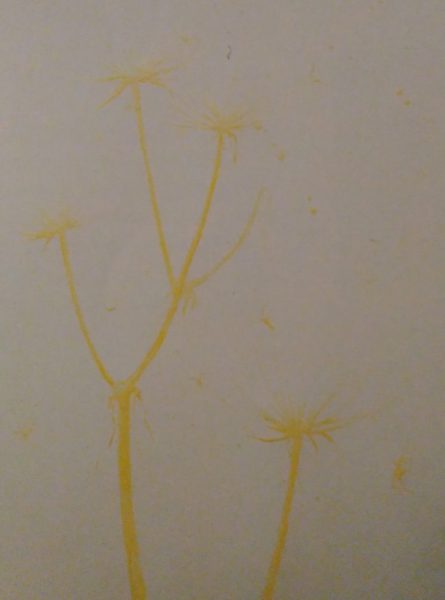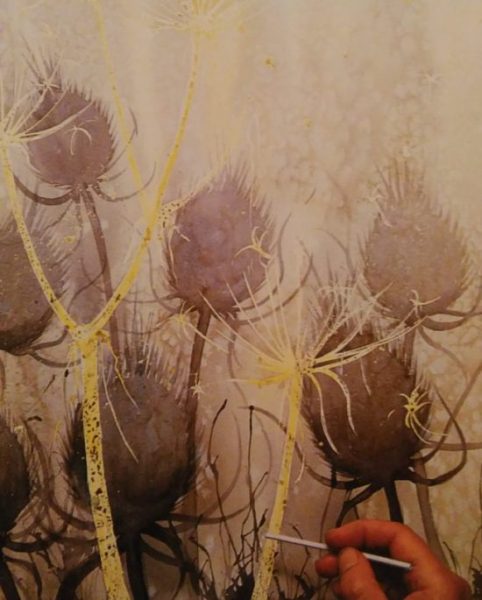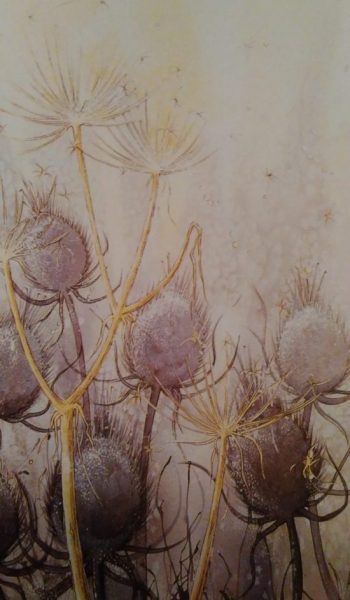You can achieve amazing effects adding salt on
This is a really fun technique and you should experiment with it and see where it takes you. Fine kitchen salt creates a fine delicate pattern while sea salt creates bigger shapes. Also, the effect is different when you use the salt on wet paint to the one when you use it on only moist paint.
You can also scrape a bit of


Thistle
On this painting, wet paint was textured with grains of salt and dry painting was scraped with fine sandpaper to create fine patterns depicting pollen and seeds floating through the air.
To create this painting you will need the following:
- Stretched cold pressed 285gr/m2
watercolor paper - Decorators brush 25mm wide
- Round brush number 12
- Round brush number 6
- Palet for mixing the
color Watercolor gouache- Thin black marker pen
- Fine sandpaper
- Straw
- Raw sienna
- Cadmium Lemon yellow
- French ultramarine
- Indigo
- Bright red
- Alizarin red


Sketching And Preparing For Painting
In order to preserve the shape and form of parsley stems while painting the dark background paint it with round brush number 6 and cover it with
Leave it all to dry for a couple of minutes and wash the brush immediately so the gouache doesn’t ruin the bristles. Speed is essential when using this technique so it is better if you have all the colours already prepared before you start. That way you won’t have to stop your work in a delicate moment because you need to mix more paint.
Prepare the colours for the background: pale yellow ( cadmium lemon yellow and raw sienna ), warm grey (French ultramarine and bright red ) and cold grey ( indigo and alizarine red). Go over the entire surface of the paper with clean water using a flat 25mm brush. Painting quickly
Before it is dry randomly add drops of warm and cold grey on the paper, darkest near the bottom of the paper and lighter one near the top end of the paper leaving some of the yellow paint visible in between. Let the colours gently blend with the wet surface and then add some grains of salt on it. leave the painting to dry for at least 20 minutes.


Building The Composition
After the painting is dry remove the extra salt from the paper revealing pale spotted pattern. Use the round brush number 12 to paint feathery round shapes of thistle with the mixture of ultramarine and bright red
To create the thin branches in the background use the straw. Add spots of the darker blue mixture here and there near the very bottom of the paper. Then take the straw and place it near every spot of blue
When the painting is fully dry scrape off the gouache using a clean finger.
Paint the parsley with a lighter spread of raw sienna using round brush number 6 leaving some small areas

Finishing Touches
Continue working with the marker pen to draw tiny spikes and leaflike curvy shapes on the thistle. Scrape off the top layer of paint on the top end of the thistle using a small piece of sandpaper in order to bring in the light and express the texture of the thistle. Make sure that the paper is completely dry before you do so if it is moist or wet the sandpaper will damage it.
Create dark green mixing French ultramarine and raw sienna to add shade on the stems of the parsley in order to give them tridimensional form. Move away from your painting and see if it gives the desired effect of composition you wanted. If you feel the need to add more details do so using the thin marker pen but make sure not to overdo it. The beauty of this painting lies in its’ cloudy and delicate appearance so too many details would ruin it.
I really hope you will have fun using this technique. It gives so much room for experimenting. This is just one of many ways of using salt with
If you have any questions or need any help regarding the subject feel free to leave them below in the comment area and I will be more than happy to answer and help in any way I can.





0 Comments